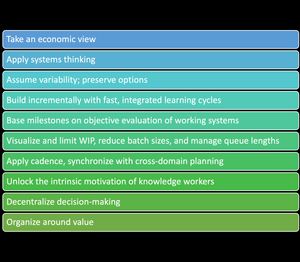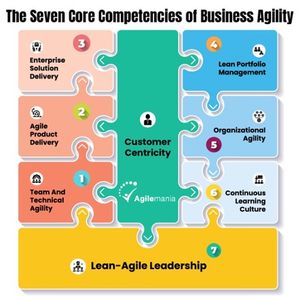SAFe® in five minutes: A Toolbox for Continuous Learning and Improvement
Imagine your organization moving with the grace of a well-rehearsed dance, each step in perfect sync with the changing tempo of market demands. This is the agility the Scaled Agile Framework (SAFe) can bring your enterprise. Far from a rigid regimen, SAFe offers a composition of adaptable practices and principles tailored to fit your unique organizational rhythm. At its heart, SAFe champions the spirit of a learning organization—one that evolves continuously to meet the ebb and flow of business needs. In a brief exploration, we'll distill the essence of SAFe, examining how its foundational values, principles, and competencies can be customized to cultivate an environment where learning and adaptation are not just encouraged but celebrated as the keystones of enduring success. So, let’s do it!
The Scaled Agile Framework (SAFe®) is often misconceived as a rigid set of practices that organizations must strictly adhere to in order to achieve agility. However, this perspective misses the mark. SAFe should be viewed not as a prescriptive process but as a versatile toolbox from which organizations can select the tools that best fit their unique contexts. Your ultimate goal? It isn't to adopt SAFe by the book. Instead, it's about igniting a culture of relentless improvement within your teams, transforming your entire organization into a vibrant learning entity. I have seen so many organizations missing out on this, trying to implement SAFe as they would any new process or way of working. Instead, you must implement SAFe by transforming the culture of the organization, starting with the leaders and extending to the teams and individuals.
Core Values
At the heart of the Scaled Agile Framework (SAFe) lie four core values. These values are foundational, not just as aspirational ideals but as practical guides steering both daily operations and strategic decisions, thereby shaping the agile culture of an organization.
Alignment: The essence of Alignment in SAFe is about synchronizing the entire organization towards unified goals. It's not just about setting targets; it's about ensuring every team member understands their role in the broader mission and how their work contributes to the organization's objectives. This shared understanding fosters a cohesive direction, critical in a rapidly changing business environment.
Transparency: Transparency is the bedrock of trust within an organization. Trust flourishes when individuals can confidently rely on one another to act with integrity, especially under challenging circumstances. In a SAFe environment, transparency isn't just about open communication; it's about creating a culture where honesty is valued, and information flows freely. This level of openness is crucial for building high-performing teams and Agile Release Trains (ARTs), and it's essential for the success of the SAFe methodology. A transparent, trust-based environment isn't just productive; it's also engaging and motivating for everyone involved.
Respect for People: The principle of 'Respect for People' is fundamental in SAFe, echoing the sentiment famously expressed by Toyota: "First we build people, then we build cars." This value underscores the fact that it is people who drive the success of any organization. Respect in this context means valuing each individual’s contribution, encouraging their growth, and recognizing their worth. It's about creating an environment where every team member feels valued and empowered to contribute their best work.
Relentless Improvement: The pursuit of perfection, though inherently unattainable, is a core tenet of Lean and by extension, SAFe. This relentless drive towards excellence stimulates continuous improvements in products, services, and processes. By consistently striving for betterment, organizations not only enhance their offerings but also increase customer satisfaction, leading to higher revenues and greater profitability. Relentless improvement in SAFe is about fostering a mindset where every challenge is an opportunity for growth and every process can be refined for greater efficiency and effectiveness.
These core values of SAFe are not just principles to be memorized; they are the lifeblood of an agile, responsive, and thriving organization. When internalized and practiced, they have the power to transform not just how work is done, but the very essence of the organization itself.
Ten principles

Embark on a voyage through the tenets of SAFe, where each principle is not merely a suggestion but a challenge to be met:
Take an Economic View: Dare to scrutinize the economic landscape with each decision you make. It's a balancing act of risk, cost, and value that demands a keen eye and a strategic mind.
Apply Systems Thinking: Challenge yourself to see beyond the parts and embrace the whole. It's a call to understand that the sum is greater than its individual pieces.
Assume Variability; Preserve Options: Embrace change as your ally. Flexibility is your weapon in a world where the only constant is change itself. Dare to keep options, to make decisions as late as possible.
Build Incrementally with Fast, Integrated Learning Cycles: Accelerate your feedback loop. It's about rapid evolution, learning swiftly from the real world facts and adapting at the speed of thought.
Base Milestones on Objective Evaluation of Working Systems: Ground your progress in reality. Set milestones that reflect not hope, but tangible, measurable, achievement.
Visualize and Limit WIP, Reduce Batch Sizes, and Manage Queue Lengths: Streamline your flow of work as if it were a river, ensuring it moves without impediment, delivering value without delay.
Apply Cadence, Synchronize with Cross-Domain Planning: Move to the rhythm of predictability and synchronization. It's the dance of multiple domains moving in harmony.
Unlock the Intrinsic Motivation of Knowledge Workers: Ignite the passion and creativity of your people. It's about cultivating an environment where autonomy and purpose thrive.
Decentralize Decision-Making: Empower decision-making at the coalface, where the work happens, where the information exists, while maintaining a strategic compass to guide those decisions.
Organize Around Value: Reorganize not just your structure but your very mindset around the swift and efficient delivery of value. It's a radical realignment of the complete structure that puts the customer at the core of every action and removes handovers and queues.
Each of these principles is a call to action, an invitation to step up and engage with the complexities of modern business. They are not just principles but provocations, challenging you to think differently, act boldly, and lead with vision. Will you rise to the challenge?
Seven core competencies
Within the robust architecture of SAFe, seven core competencies serve as the pillars that uphold the agile edifice. These competencies are not just a checklist to be marked off; they are the lifeblood of a thriving agile enterprise, each flowing into the other to create a cohesive and dynamic whole.

Lean-Agile Leadership is the keystone, setting the tone for a culture steeped in agile values. It's where the transformation begins, with leaders who not only preach but practice agility in every decision and interaction.
Team and Technical Agility are the heartbeat of SAFe, where cross-functional teams pulse with the rhythm of innovation, delivering quality solutions with a cadence that matches the urgency of customer needs.
Agile Product Delivery is the creative mind, constantly seeking to understand and fulfill the customer's desires, using design thinking as a compass to navigate the complex landscape of product development.
Enterprise Solution Delivery is the organization's backbone, ensuring that large-scale solutions don't become unwieldy but move with grace and alignment, delivering complex solutions that are as elegant as they are effective.
Lean Portfolio Management is the strategic arm, reaching into the future to grasp the opportunities that lie ahead, aligning the organization's vision with the practical steps needed to bring it to fruition.
Organizational Agility is the organization's reflexes, the ability to pivot at a moment's notice, to adapt to new challenges and seize new opportunities with speed and grace.
And finally, the Continuous Learning Culture is the organization's growth mindset, an unquenchable thirst for knowledge and improvement that ensures the journey of agility is never at a standstill but always moving forward, always evolving.
Together, these competencies weave a tapestry of agility that can cover the entire organization, making it capable of responding to change and poised to lead it. In the world of SAFe, these competencies are the difference between an organization that survives the waves of change and one that surfs it to new heights of innovation and success.
Conclusion
In summary, the Scaled Agile Framework (SAFe) should not be misconstrued as a stringent set of rules and procedures to which organizations must rigidly adhere. Instead, SAFe should be seen as a dynamic and adaptable framework, one that serves as a catalyst for cultivating a vibrant, agile culture within an organization. This framework is underpinned by four core values, guided by ten foundational principles, and upheld through seven key competencies.
The true essence of SAFe lies in its ability to foster an environment where these values, principles, and competencies interweave to support continuous learning, adaptation, and growth. It's about creating a workspace where alignment, transparency, respect for people, and relentless improvement are not just ideals, but lived practices that shape everyday actions and strategic decisions.
By embracing the spirit of SAFe, organizations can move beyond the traditional, rigid models of operation. They can evolve into learning entities, adaptable and responsive to the ever-changing landscape of modern business. SAFe is about embarking on a journey of transformation — one that reshapes not only how teams and leaders operate but also the very culture and ethos of the organization.
As you stand at the threshold of organizational change, consider how the principles and practices of SAFe can guide you in fostering an agile, resilient, and thriving enterprise. Remember, adopting SAFe is not merely about implementing a framework; it’s about igniting a cultural shift towards agility, collaboration, and continuous improvement.
Ready to take the first step? Reach out. Together, we can chart a course to a future where your organization doesn't just adapt to change—it thrives on it. Let's begin this transformative journey and unlock the full potential of your enterprise. Don't hesitate—contact me, and let's navigate the path to agility together.
Last updated May 27, 2025
